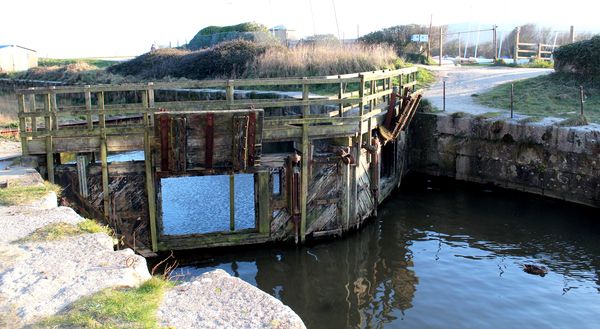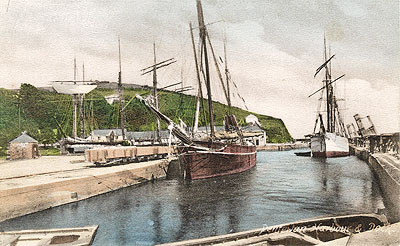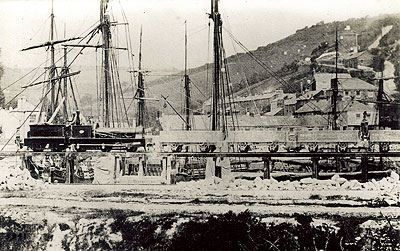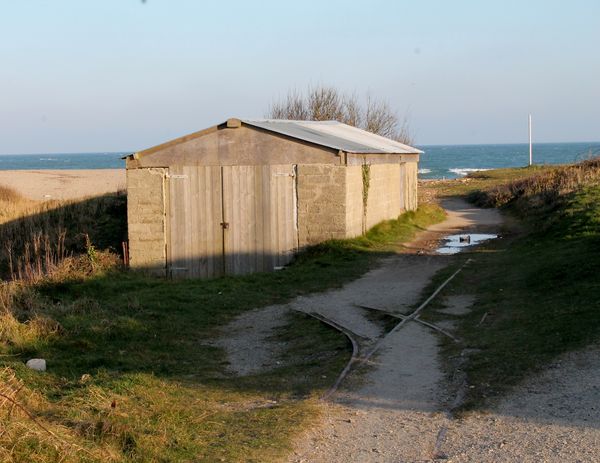Check out Underwater Photography Forum section of our forum.
"Bentewyn"... (Pentewan)
Feb 19, 2013 15:19:37 #
Pentewan (Cornish= Bentewyn... translates as "Foot of the radiant stream".. )
The name Pentewan is from the Cornish language, PEN meaning a headland and TEWAN or Towan meaning a sand-hill, hillocks or dunes. The village is built around a circular hill known as The Round. It is known that an Iron Age settlement was situated on this hill as traces of hut circles and an entrenchment have been discovered. Pentewan is mentioned in the Doomsday Book of 1086 where it states, The Manor of Pentewan was held by Osulf. During the 13th century the Manor was held by the Wise or Wyse family, and passing through various marriages the Manor during the 16th and 17th centuries became the home of the Dart family. From very early times until the mid 19th century tin streaming was carried out in the Pentewan Valley and river estuary. Fishing was the main occupation before the harbour was built and there were fish cellars on the east side of the village and at Portgiskey. In 1549 John Leland wrote; Pentowan a sandy bay witherto fischer bootes repair for a socour. Tonkin in 1739 said; Pentewan would form a pretty little port but for the bar of sand...
The first harbour was built in 1744 by the Hawkins family, landowners who lived at Trewithen, Probus. In 1818 Sir Christopher Hawkins entered into an agreement with a John Stanley of London, and others to redevelop the harbour. The work was completed and the harbour opened in February 1826 trading in china clay, coal, limestone and timber. A 500 feet long pier was constructed from the dock basin out to the sea, ships entering and leaving through a channel with a double lock gate 26 feet wide. In 1831 a new pier head was built.
The narrow roads connecting the harbour at Pentewan with the china clay drys were most inadequate for conveying wagon loads of goods. So in 1829 a horse drawn tramway was opened up through Pentewan Valley to the town of St. Austell. The tramway ran almost due north from the port without any earthworks or engineering features of any size, closely hugging the river most of the way, for nearly four miles and ran into a collection depot off West Hill at St. Austell. In 1873 the tramway was converted into a 26 narrow gauge railway, rails being attached to wooden sleepers rather than the original granite blocks. The first steam locomotive was built for the railway by Manning Wardle and it was named Pentewan and had an 0-6-0 wheel arrangement with a four wheeled tender. This loco worked until 1886 when a similar engine arrived named Trewithen. The third engine also built by Manning Wardle was a bulky 0-6-2 saddle tank named Canopus arrived at Pentewan in December 1901. After 1912 Canopus shared the work on the railway with Pioneer a 2-6-2 saddle tank purchased from the Chattenden and Uppnor military railway. The rolling stock consisted of forty-two four wheeled wagons each able to carry 4 to 5 tons of china clay.
The railway was noted for the annual Sunday School Tea Treat Trains. During the summer months the churches and chapels around the area hired the railway for the afternoon and conveyed their scholars, family and teachers to Pentewan to partake in their tea treat at by the sea. Because of the infiltration of the GWR into the china clay area, the rise of the ports of Fowey and Par, traffic on the Pentewan railway was greatly affected and the last load of clay was brought down the railway on 29th January 1918.
Like most villages in the 19th century, Pentewan was more or less self sufficient. Various tradesmen and merchants lived in and around the area. There was Arthur Tyzzer the carpenter, Charlie Davey the builder, Williams and Tucker the butchers, and Charlie Beard the cobbler. There were three pubs in the village, the Ship Inn, the Jolly Sailor and the Hawkins Arms where the sailors and dock workers could quench their thirst. Groceries and ships supplies could be purchased from Tyzzers, Mrs. Marks, Captain Prettyman and Mr. Prynn. On the hill was the Wesleyan Chapel and the Bible Christians had a chapel in North Road. The church on The Terrace is the only place of worship in the village today.
Pentewan today is a popular holiday resort. Even during the 1920s and 1930s people came to stay here, with the odd tent or caravan being stationed over near Sconhoe Farm. The G.W.R Holiday Haunts book listed Bed and Breakfast establishments in the village. The area known as the Winnick since the 1950s has been used as a caravanning and camping ground, with its long sandy beach, it is good for bathing, diving, and when conditions are right is used in the winter months by local board-surfers and wind surfers.
The caravan and camping ground is full during July and August colourful tents and flags. Pentewan situated in central Cornwall is an ideal base for touring around the county, and is very close to popular attractions such as, Eden, The Lost Gardens of Heligan, Mevagissey and Charlestown. There are several walks around the village and the coast path provides wonderful views of St Austell Bay.
Gary
The name Pentewan is from the Cornish language, PEN meaning a headland and TEWAN or Towan meaning a sand-hill, hillocks or dunes. The village is built around a circular hill known as The Round. It is known that an Iron Age settlement was situated on this hill as traces of hut circles and an entrenchment have been discovered. Pentewan is mentioned in the Doomsday Book of 1086 where it states, The Manor of Pentewan was held by Osulf. During the 13th century the Manor was held by the Wise or Wyse family, and passing through various marriages the Manor during the 16th and 17th centuries became the home of the Dart family. From very early times until the mid 19th century tin streaming was carried out in the Pentewan Valley and river estuary. Fishing was the main occupation before the harbour was built and there were fish cellars on the east side of the village and at Portgiskey. In 1549 John Leland wrote; Pentowan a sandy bay witherto fischer bootes repair for a socour. Tonkin in 1739 said; Pentewan would form a pretty little port but for the bar of sand...
The first harbour was built in 1744 by the Hawkins family, landowners who lived at Trewithen, Probus. In 1818 Sir Christopher Hawkins entered into an agreement with a John Stanley of London, and others to redevelop the harbour. The work was completed and the harbour opened in February 1826 trading in china clay, coal, limestone and timber. A 500 feet long pier was constructed from the dock basin out to the sea, ships entering and leaving through a channel with a double lock gate 26 feet wide. In 1831 a new pier head was built.
The narrow roads connecting the harbour at Pentewan with the china clay drys were most inadequate for conveying wagon loads of goods. So in 1829 a horse drawn tramway was opened up through Pentewan Valley to the town of St. Austell. The tramway ran almost due north from the port without any earthworks or engineering features of any size, closely hugging the river most of the way, for nearly four miles and ran into a collection depot off West Hill at St. Austell. In 1873 the tramway was converted into a 26 narrow gauge railway, rails being attached to wooden sleepers rather than the original granite blocks. The first steam locomotive was built for the railway by Manning Wardle and it was named Pentewan and had an 0-6-0 wheel arrangement with a four wheeled tender. This loco worked until 1886 when a similar engine arrived named Trewithen. The third engine also built by Manning Wardle was a bulky 0-6-2 saddle tank named Canopus arrived at Pentewan in December 1901. After 1912 Canopus shared the work on the railway with Pioneer a 2-6-2 saddle tank purchased from the Chattenden and Uppnor military railway. The rolling stock consisted of forty-two four wheeled wagons each able to carry 4 to 5 tons of china clay.
The railway was noted for the annual Sunday School Tea Treat Trains. During the summer months the churches and chapels around the area hired the railway for the afternoon and conveyed their scholars, family and teachers to Pentewan to partake in their tea treat at by the sea. Because of the infiltration of the GWR into the china clay area, the rise of the ports of Fowey and Par, traffic on the Pentewan railway was greatly affected and the last load of clay was brought down the railway on 29th January 1918.
Like most villages in the 19th century, Pentewan was more or less self sufficient. Various tradesmen and merchants lived in and around the area. There was Arthur Tyzzer the carpenter, Charlie Davey the builder, Williams and Tucker the butchers, and Charlie Beard the cobbler. There were three pubs in the village, the Ship Inn, the Jolly Sailor and the Hawkins Arms where the sailors and dock workers could quench their thirst. Groceries and ships supplies could be purchased from Tyzzers, Mrs. Marks, Captain Prettyman and Mr. Prynn. On the hill was the Wesleyan Chapel and the Bible Christians had a chapel in North Road. The church on The Terrace is the only place of worship in the village today.
Pentewan today is a popular holiday resort. Even during the 1920s and 1930s people came to stay here, with the odd tent or caravan being stationed over near Sconhoe Farm. The G.W.R Holiday Haunts book listed Bed and Breakfast establishments in the village. The area known as the Winnick since the 1950s has been used as a caravanning and camping ground, with its long sandy beach, it is good for bathing, diving, and when conditions are right is used in the winter months by local board-surfers and wind surfers.
The caravan and camping ground is full during July and August colourful tents and flags. Pentewan situated in central Cornwall is an ideal base for touring around the county, and is very close to popular attractions such as, Eden, The Lost Gardens of Heligan, Mevagissey and Charlestown. There are several walks around the village and the coast path provides wonderful views of St Austell Bay.
Gary



The last trading ship left in 1940. After that, the harbour entrance gradually silted up, though it was still possible for small boats to enter the harbour in the 1960s. Now, although the water-filled basin remains, Pentewan harbour is entirely cut off from the sea.[2][3]








Pentewan Harbour (c) 1900

Pentewan Railway locomotive Pentewan on the wooden loading trestle (c) 1880

In 1829, Sir Christopher Hawkins made further improvements by linking the harbour to St Austell by means of a horse-drawn tramway that hauled china clay from the quarries on St Austell moor and tin from the Polgooth mines for shipment from Pentewan. Coal was shipped in and transported to the mines and (later) to the St Austell gasworks. In 1874, the engineer John Barraclough Fell replaced the tramway with a narrow gauge railway. This operated till 1918, when the rails and locomotives were requisitioned by the War Office

Feb 19, 2013 15:44:52 #
Feb 20, 2013 16:17:38 #
waterbug49307
Loc: All over, currently Big Rapids Michigan
Thanks for sharing. Wonderful series of an interesting history.
Check out Film Photography section of our forum.
Feb 20, 2013 16:23:01 #
waterbug49307 wrote:
Thanks for sharing. Wonderful series of an interesting history.
Your welcome ..
Gary
Feb 20, 2013 16:23:36 #
Feb 20, 2013 16:39:28 #
Very interesting history and great photos. I really do love posts like this one.
Feb 20, 2013 16:43:47 #
Dixiegirl wrote:
Very interesting history and great photos. I really do love posts like this one.
Thanks Dixiegirl... I will do another soon ...
Gary
Feb 20, 2013 23:24:25 #
Feb 21, 2013 11:50:55 #
If you want to reply, then register here. Registration is free and your account is created instantly, so you can post right away.
Check out Bridge Camera Show Case section of our forum.




